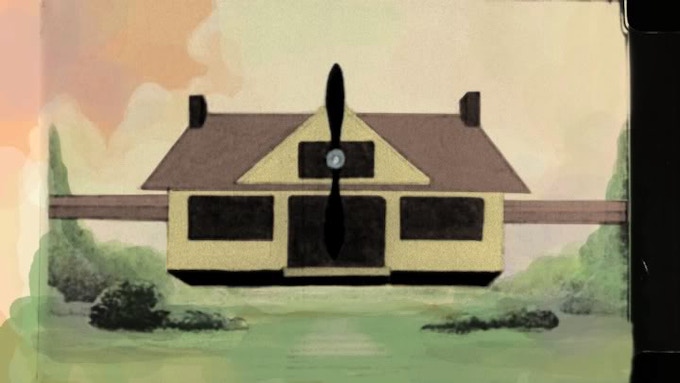
Written by Brandie Ashe
Early 20th-century artist and cartoonist Winsor McCay is not exactly a household name, at least in comparison to other stalwarts of early animation like Walt Disney (though this fall’s Google Doodle honoring McCay’s pioneering comic strip Little Nemo in Slumberland went a long way towards familiarizing him with modern audiences). But there is no denying his groundbreaking influence in the development of the animated genre. In fact, McCay, whose work predated Disney’s by more than a decade, practically invented the concept of animated film, spending thousands of hours producing, directing, and drawing every frame of his cartoons by hand, usually unassisted.
Unlike his few predecessors, McCay did not merely play tricks with the camera; he crafted engaging features that set the stage for the cartoons we know and love today. His 1914 short Gertie the Dinosaur is recognized by film scholars as the first instance of an animated character demonstrating a unique personality, and greatly influenced future artists’ attempts to bring their own creations to life. His 1918 production The Sinking of the Lusitania demonstrates animation’s ability to not only tell fanciful tales, but to reflect real-life stories in a documentary sense (and, by extension, use those stories as propaganda for a specific agenda). His process in making these shorts was painstaking, but by all accounts, it was a labor of love, for McCay was endlessly fascinated with this new medium and its potential.
In 1921, McCay adapted three stories from his popular comic strip Dream of the Rarebit Fiend for the screen. The Rarebit Fiend strip illustrates the wild and crazy nightmares that emerge after the dreamer overindulges in a dinner of Welsh rarebit (essentially, a rich cheese sauce poured over toast). As one might imagine, these comics are surrealistically inspired, befitting a dreamy landscape, and the screen adaptations are no less imaginative. The final cartoon, The Flying House, is particularly inventive, depicting one woman’s nightmare as her husband turns their home into a flying machine so as to escape their creditors. After soaring over the city, causing chaos and destruction, the couple finds themselves in outer space, dodging moon monsters and wayward rockets, before the wife awakens and gratefully acknowledges that it was all just a dream.
Ninety years after The Flying House was produced, independent animator and two-time Academy Award nominee Bill Plympton began a Kickstarter campaign to “revitalize” the cartoon, which has suffered nearly a century’s worth of wear and tear. But rather than merely restore McCay’s original animation with a new soundtrack, as has been done with other McCay productions over the years, Plympton resolved to completely overhaul the cartoon. As documented in the recent Microcinema DVD release The Flying House Project, Plympton and his team cleaned up the original frames, then added color and a new score. Additionally, the intertitles and “word bubbles” that McCay had crafted to relay the dialogue to viewers was eliminated, replaced by vocal work from noted actors Patricia Clarkson and Matthew Modine (who also executive-produced Plympton’s project).
The end result is nothing short of an animated travesty. By colorizing and adding sound to a silent, black-and-white film, Plympton has, rather unapologetically, altered the essence of McCay’s work, throwing about the terms “re-imagining” and “remastering” as justification for his production choices. But can you truly call this a “remastering” of The Flying House if it no longer looks the way it did 90 years ago? It’s one thing to clean up scratches and dings; it’s quite another to alter the frames by removing McCay’s words, speeding up the animation (indeed, Plympton’s version is nearly two minutes shorter than the original), and adding sound effects and additional dialogue. This is not Winsor McCay’s Flying House. This is Bill Plympton’s shiny new update, and it simply does not work.
The Flying House Project DVD thankfully features the unadulterated version of McCay’s masterpiece, so viewers unfamiliar with McCay’s original can compare it to Plympton’s candy-coated variation. The disc includes several special features focusing on the creation of the new version, including the original Kickstarter ad designed to solicit donations and a “making of” documentary that highlights the production process. The DVD also features interviews with several notable figures in the world of modern animation and film scholarship, including Jerry Beck and Leonard Maltin, who ultimately give Plympton’s efforts their collective seal of approval.
Far be it for me to disagree with such distinguished members of the field, but I simply cannot get over my frustration with Plympton’s House project. While it is nice to see McCay getting this kind of attention nowadays (and while, like Beck, I remain hopeful that those who see this film will be interested enough to further explore McCay’s work), it is nonetheless disappointing to see a purported fan of the artist’s work appropriate it in such an unappealing fashion. McCay’s legacy arguably would have been better served by Plympton restoring the cartoonist’s original vision as opposed to trying to update it in a vain (and somewhat egotistical) attempt to make it “relevant” for modern viewers. Winsor McCay’s art does not need embellishment and it certainly does not need to be “fixed”—it’s beautiful all on its own, in all its black-and-white, silent, word-bubbled glory. Adding color and sound to this classic cartoon is, at least in my mind, akin to colorizing The General and asking Jim Belushi to dub Buster Keaton’s voice—just plain wrong, wrong, wrong.